 W
WThe birds of Thailand included 1076 species as of 2019. Of them, more than 100 are rare or accidental, six have been introduced by humans, and eight have been extirpated. Seventy two of the country's species are globally threatened.
 W
WThe greater adjutant is a member of the stork family, Ciconiidae. Its genus includes the lesser adjutant of Asia and the marabou stork of Africa. Once found widely across southern Asia, mainly in India but extending east to Borneo, the greater adjutant is now restricted to a much smaller range with only three breeding populations; two in India, with the largest colony in Assam, a smaller one around Bhagalpur; and another breeding population in Cambodia. They disperse widely after the breeding season. This large stork has a massive wedge-shaped bill, a bare head and a distinctive neck pouch. During the day, it soars in thermals along with vultures with whom it shares the habit of scavenging. They feed mainly on carrion and offal; however, they are opportunistic and will sometimes prey on vertebrates. The English name is derived from their stiff "military" gait when walking on the ground. Large numbers once lived in Asia, but they have declined to the point of endangerment. The total population in 2008 was estimated at around a thousand individuals. In the 19th century, they were especially common in the city of Calcutta, where they were referred to as the "Calcutta adjutant" and included in the coat of arms for the city. Known locally as hargila and considered to be unclean birds, they were largely left undisturbed but sometimes hunted for the use of their meat in folk medicine. Valued as scavengers, they were once depicted in the logo of the Calcutta Municipal Corporation.
 W
WThe spot-necked babbler is a species of bird in the family Timaliidae.
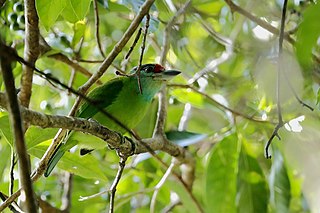 W
WThe turquoise-throated barbet is an Asian barbet found in Thailand. The barbets get their name from the bristles which fringe their heavy bills; this species eats fruits and insects. It used to be considered a subspecies of the blue-throated barbet.
 W
WThe spectacled barwing is a species of bird in the family Leiothrichidae.
 W
WThe puff-throated bulbul is a songbird in the bulbul family, Pycnonotidae. The species was first described by Robert Swinhoe in 1870. It is found in Southeast Asia. Its natural habitat is subtropical or tropical moist lowland forests.
 W
WThe white-headed bulbul is a songbird species in the bulbul family, Pycnonotidae.
 W
WThe crested bunting is a species of bird in the family Emberizidae, from the northern regions of the Indian Subcontinent stretching eastward to Southeast Asia.
 W
WThe crested partridge also known as the crested wood partridge, roul-roul, red-crowned wood partridge, green wood quail or green wood partridge is a gamebird in the pheasant family Phasianidae of the order Galliformes, gallinaceous birds. It is the only member of the genus Rollulus.
 W
WThe crested fireback is a medium-sized, up to 70 cm long, forest pheasant with a peacock-like dark crest, bluish black plumage, reddish brown rump, black outer tail feathers, red iris and bare blue facial skin. The female is a brown bird with short crest, blue facial skin and spotted black-and-white below.
 W
WThe Siamese fireback also known as Diard's fireback, is a fairly large, approximately 80 cm long, pheasant. The male has a grey plumage with an extensive facial caruncle, crimson legs and feet, ornamental black crest feathers, reddish brown iris and long curved blackish tail. The female is a brown bird with blackish wing and tail feathers.
 W
WThe Chinese blue flycatcher is a small passerine bird in the flycatcher family, Muscicapidae. The Chinese blue flycatcher is found in southern China and the Malay Peninsula. It previously was considered a subspecies of the blue-throated blue flycatcher.
 W
WThe rufous-browed flycatcher is a species of bird in the family Muscicapidae. It is found in Indonesia, Laos, Malaysia, Myanmar, Thailand, and Vietnam. Its natural habitat is subtropical or tropical moist montane forests. It was formerly placed in the genus Ficedula.
 W
WThe giant ibis, the only species in the monotypic genus Thaumatibis, is a wading bird of the ibis family, Threskiornithidae. It is confined to northern Cambodia, with a few birds surviving in extreme southern Laos and a recent sighting in Yok Đôn National Park, Vietnam.
 W
WHodgson's hawk-cuckoo, also known as the whistling hawk-cuckoo is a species of cuckoo found in north-eastern India, Myanmar, southern China and southeast Asia.
 W
WAusten's brown hornbill is a species of hornbill found in forests from northeastern India and south to Vietnam and northern Thailand. It is sometimes included as a subspecies of Tickell's brown hornbill.
 W
WTickell's brown hornbill, also known as the rusty-cheeked hornbill, is a species of hornbill found in forests in Burma and adjacent western Thailand. Austen's brown hornbill is sometimes considered as a subspecies of Tickell's brown hornbill.
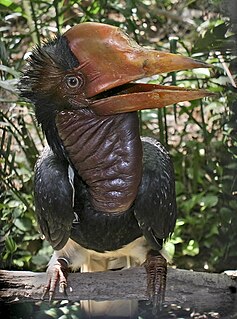 W
WThe helmeted hornbill is a very large bird in the hornbill family. It is found on the Malay Peninsula, Sumatra, Borneo, Thailand and Myanmar. The casque accounts for some 11% of its 3 kg weight. Unlike any other hornbill, the casque is almost solid, and is used in head-to-head combat among males. It is a belief among the Punan Bah that a large helmeted hornbill guards the river between life and death.
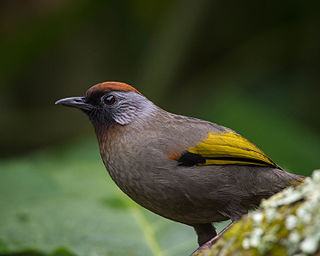 W
WThe silver-eared laughingthrush is a species of bird in the family Leiothrichidae. It is found in southern Yunnan, Laos, Myanmar, Thailand and Vietnam. It was formerly considered a subspecies of the chestnut-crowned laughingthrush, G. erythrocephalus.
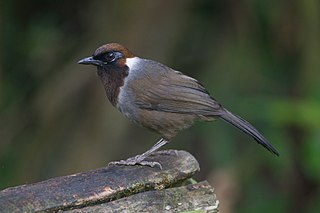 W
WThe white-necked laughingthrush is a species of bird in the family Leiothrichidae. It is found in Yunnan, Laos, Myanmar and Thailand. Its natural habitats are subtropical or tropical moist lowland forests and subtropical or tropical moist montane forests.
 W
WThe orange-bellied leafbird is a bird native to the central and eastern Himalayas, Yunnan and northern parts of Southeast Asia. The scientific name commemorates the English naturalist Thomas Hardwicke.
 W
WThe scarlet-faced liocichla is a bird in the family Leiothrichidae. The species was recently reclassified as separate from the red-faced liocichla, although some taxonomists consider it to be conspecific. It is found in Myanmar, Thailand, Vietnam, and southern China.
 W
WThe white-eyed river martin is a passerine bird, one of only two members of the river martin subfamily of the swallows. Since it has significant differences from its closest relative, the African river martin, it is sometimes placed in its own genus, Eurochelidon. First found in 1968, it is known only from a single wintering site in Thailand, and may be extinct, since it has not been seen since 1980 despite targeted surveys in Thailand and neighbouring Cambodia. It may possibly still breed in China or Southeast Asia, but a Chinese painting initially thought to depict this species was later reassessed as showing pratincoles.
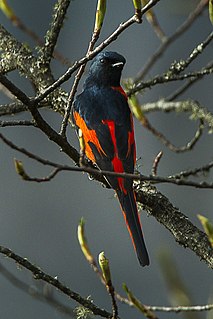 W
WThe long-tailed minivet is a species of bird in the family Campephagidae. It is found in southern and south-eastern Asia where it occurs in Afghanistan, Bangladesh, Bhutan, China, India, Laos, Myanmar, Nepal, Pakistan, Thailand, and Vietnam. Its natural habitats are subtropical or tropical moist lowland forest and subtropical or tropical moist montane forest.
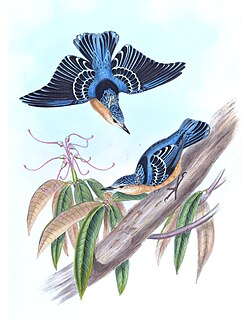 W
WThe beautiful nuthatch is a bird species in the family Sittidae, collectively known as nuthatches. It is a large nuthatch, measuring 16.5 cm (6.5 in) in length, that is not sexually dimorphic. Its coloration and markings are dramatic, the upper parts being black and azure, streaked with white and pale blue on the head and lined with the same colors on the wing feathers. The underparts are orange, and the eyebrow and throat are ochre. An irregular, dark eyestripe highlights its eye. S. formosa's ecology is not fully described, but it is known to feed on small insects and larvae found on the trunks and epiphyte-covered branches of trees in its range. Reproduction takes place from April to May; the nest is placed in the hole of an oak, rhododendron, or other large tree. The nest is made of plant material and fur in which the bird typically lays four to six eggs.
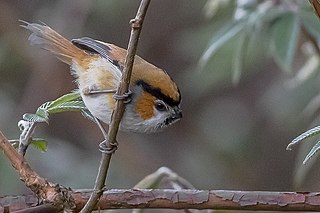 W
WThe black-throated parrotbill is a parrotbill species often placed with the Old World babblers or in a distinct family Paradoxornithidae, but it actually seems to belong to the Sylviidae.
 W
WThe short-tailed parrotbill is a species of bird in the family Paradoxornithidae. It is found in China, Laos, Myanmar, Thailand, and Vietnam. Its natural habitat is subtropical or tropical moist lowland forests.
 W
WThe bar-backed partridge, also known as the brown-breasted hill-partridge, is a species of partridge in the family Phasianidae. It is found in southwestern China and Southeast Asia.
 W
WThe green-legged partridge, also known as the scaly-breasted partridge or green-legged hill-partridge, is a bird species in the family Phasianidae. It is found in forest in Indochina, ranging slightly into southernmost China (Yunnan). The Vietnam partridge is now usually considered a subspecies.
 W
WThe long-billed partridge is a species of bird in the family Phasianidae.
 W
WThe gray peacock-pheasant, also known as Burmese peacock-pheasant, is a large Asian member of the order Galliformes. It is the national bird of Myanmar.
 W
WThe silver pheasant is a species of pheasant found in forests, mainly in mountains, of mainland Southeast Asia, and eastern and southern China, with introduced populations in Hawaii and various locations in the US mainland. The male is black and white, while the female is mainly brown. Both sexes have a bare red face and red legs. It is common in aviculture, and overall also remains common in the wild, but some of its subspecies are rare and threatened.
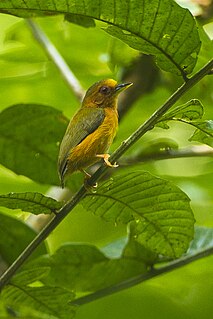 W
WThe rufous piculet is a species of bird in the family Picidae. It is found in Brunei, Indonesia, Malaysia, Myanmar, and Thailand. Its natural habitats are subtropical or tropical moist lowland forests and subtropical or tropical moist montane forests. This species is one of the world's smallest woodpeckers and is the smallest woodpecker found outside the Americas. In this species the length can range from 8 to 10 cm and the average body mass is around 9.2 g (0.32 oz).
 W
WThe blue pitta is a species of bird in the family Pittidae found in the northeastern Indian subcontinent, southern China, and Indochina. It typically lives in moist forests but can also inhabit dry forest. It is an unobtrusive, solitary bird which feeds by foraging on the ground for insects and other small invertebrates.
 W
WThe dark-backed sibia is a bird species in the family Leiothrichidae. In former times it was included the black-headed sibia, H. desgodinsi. Together with most other sibias, it is sometimes separated in the genus Malacias. It is found in China, Myanmar and Thailand. Its natural habitat is subtropical or tropical moist montane forests.
 W
WThe slaty-bellied tesia is a species of warbler in the family Cettiidae.
 W
WThe scaly thrush is a member of the thrush family Turdidae.
 W
WThe yellow-cheeked tit is a species of bird in the family Paridae.
 W
WThe grey treepie, also known as the Himalayan treepie, is an Asian treepie, a medium-sized and long-tailed member of the crow family. The species was first described by Robert Swinhoe in 1863. They are widely distributed along the foothills of the Himalayas in the Indian Subcontinent and extending into Indochina, southern mainland China and Taiwan. The populations vary in plumage and several are named as subspecies.
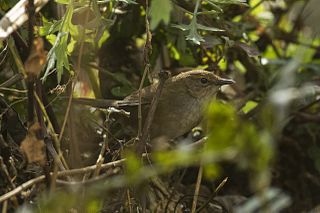 W
WThe russet bush warbler is a songbird species. Formerly placed in the "Old World warbler" assemblage, it is now placed in the newly recognized family Locustellidae. B. mandelli was until recently considered a subspecies of B. seebohmi, and the name "russet bush warbler" was applied to the entire species complex. After this was split up, Benguet bush warbler was proposed as a new name for B. seebohmi proper. The species is found in southeast Asia.
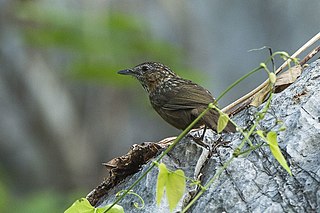 W
WThe limestone wren-babbler is a species of bird in the family Pellorneidae. It is found in China, Laos, Myanmar, Thailand, and Vietnam. Its natural habitat is subtropical or tropical moist lowland forest.
 W
WThe Burmese yuhina is a species of bird in the family Zosteropidae. It is found in Myanmar and Thailand. Its natural habitat is subtropical or tropical moist montane forests.
 W
WThe striated yuhina is a bird species in the white-eye family Zosteropidae.